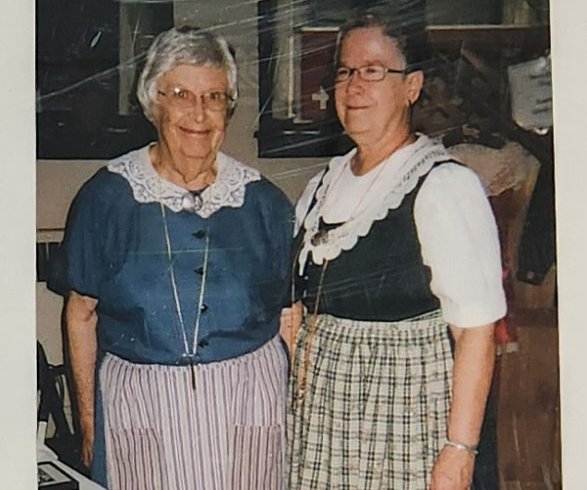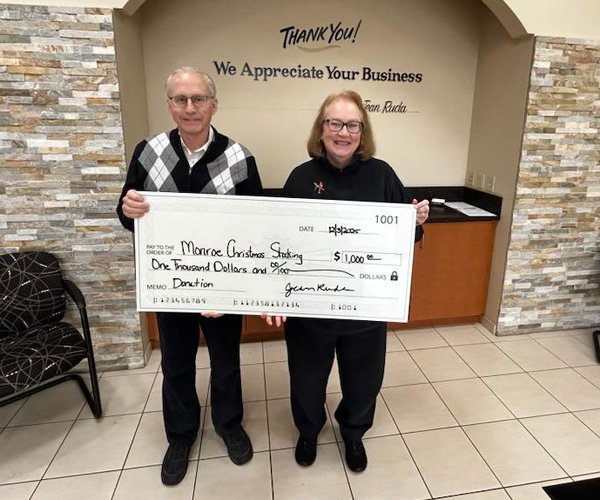MONTICELLO — The Freitag homestead that was once a bustling dairy farmhouse filled with busy children and active animals may not see the same day-to-day operations it once did.
However, it still comes to life several times a year, bringing together families connected through lineage who were once attached to the farm in one way or another. The Queen Anne now serves as the ultimate testament to the success of Swiss immigrants, and bringing families together who may never otherwise connect.
The home is distinct because of its family roots, but it’s the historic landmark that also tells a tale of the past. The homestead’s value has become priceless, once built from an emigrant from the canton of Glarus, Switzerland, who helped found New Glarus and provide a start to the first Swiss cheese factory in Green County.
Cally Parkinson is the granddaughter of one of the four original children whose parents built and lived in the home, and said the various generations who still come to enjoy the place is part of why they take the time and energy to preserve it.
“The heart of our family has always been to keep it as a symbol of our heritage,” Parkinson said.
This year will be a special celebration for the family as they mark its centennial year and hope that more family than usual will make the trek to Green County to rejoice in its success.
The heart of our family has always been to keep it as a symbol of our heritage.Cally Parkinson
History
Fridolin Streiff, an emigrant from the canton of Glarus in Switzerland, purchased the land where the Freitag homestead sits after coming to the United States. He was one of the founders of New Glarus, and for several years led the colony of impoverished Swiss settlers.
The historic farm started in 1848 in the Town of Washington in Green County. It’s known for being the site of the first Swiss cheese factory in Wisconsin and was added to the National Register of Historic Places in 2005.
Once established, Streiff began to build the farm with his wife, Katharina. They first built a log home and other buildings that no longer stand.
In 1869 the Streiffs sold the farm to Dietrich and Verena Freitag, also of Glarus, Switzerland. The same year, Nikolaus Gerber began to make Swiss cheese in the Streiff’s old log home. Milk was supplied by the Freitag’s herd and other local farms. It was the first Swiss cheese factory in Wisconsin, and operated in the cabin until 1877.
Check it out ...
Other surviving buildings on the farm:
■ HOG BARN: The hog barn was built in 1880 by Dietrich Freitag. The gable-roofed bank barn has a wood frame on a fieldstone foundation. The hog pens were originally in the basement. A corn crib is built into each end of the building and a stone loading ramp leads to the center door. A ventilator sits atop the venter of the gable roof.
■ DAIRY BARN: The dairy barn was built around 1880. It is a gable-roofed bank barn. Dietrich’s original section is 90x40 feet, with the first story walls of thick fieldstone. Above is the hay loft, with tall openings on the side filled with louvers for ventilation. On top of the ridge are two square ventilators. A milk house was added in the 1950s and other structures over the years.
Dietrich and the farmers took over the factory from Gerber in 1875 and operated it until 1900. Gerber’s equipment is still on display in the Swiss Historical Village in New Glarus.
In 1895 Dietrich’s sons Nicholas and Henry bought the farm and Nicholas bought out Henry’s share shortly after Dietrich died in 1900. Nicholas ran the farm for the rest of his life, and was also a director of the Bank of Monticello and was active in the Reformed Church in Monticello.
In 1906 Nicholas and Elsbeth Freitag built the home that still stands today and is the place the family gathers when they visit. They build it in the then popular Queen Anne style, with a limestone foundation and red brick walls, with eaves supported by ornamental brackets, leading to a gable and hip roof. A one-story veranda wraps the front of the house, with a turret at one corner. Inside, the house has hardwood floors and plaster walls with varnished woodwork. The house has no fireplaces; it was heated by radiators from the start.
With many of the original finishes and furnishings intact, the Freitag house is said to be one of the finest Queen Annes in Green County.
Family
Nicholas Freitag, who died in 1952, was the last person to live in the home, although some have visited for lengthy stays over the years.
Parkinson said the home is now run by shareholders and a board of directors with elected officers. An executive group of four people, including Parkinson, speak regularly regarding the farm. The home is now run like a small business.
Now on the verge of celebrating 150 years, it’s important to many that the Freitag homestead stays in the family and that they raise the next generation to stay committed to it. The end goal of everyone, she said, is to keep the home’s upkeep, historical charm and provide a place where the family can gather.
“I want the gift to be given to my children,” Parkinson said. “They love the farm — and now I want my grandchildren to love the farm.”
Parkinson, who grew up in Indiana, said her memories include a fully operating dairy farm, and a yard that was filled often with kittens and calves she enjoyed during her long summer visits. She now feels fortunate to be part of a group that has enough resources to maintain the home that shows the value of immigrants and how well they could do after settling in Green County.
Along with planning a summer event and other stays during the year for different family groups, there are also scheduled work weekends to tackle projects. They lean on elders in the family to tell the stories of the mementos they come across in the home for safekeeping.
Enough income from tenants who live in the smaller white house on the property as well as money from crop land provides for the home’s necessities. The farm, including the home and crop land, spans around 100 acres. Gifts from the family and savings help with capital improvements.
Recently a bigger project to save the home’s foundation was done. The family trusts Bruni-Miller Construction out of Monroe to ensure the home’s history stays intact.
“I want the gift to be given to my children. They love the farm — and now I want my grandchildren to love the farm.Cally Parkinson
Parkinson said they have been instrumental in keeping the historic preservation of the farm while maintaining its upkeep. In recent years, they have repaired the front porch, designed and built a laundry room and completed the biggest project of an underground concrete wall to protect the west foundation from damage.
Photos and books filled with memories from the home are abundant. A handwritten account of a triple wedding held on the property in 1894 is accounted in full with photos.
An invitation from Elsbeth and Nicholas Freitag dated August 1969 asks guests to join for the 100th anniversary of the homestead. Guests were treated to an outdoor buffet after six centennial trees were planted by the eldest of each family, a dedication of the coat of arms plaque on the barn was held and then a viewing of the plaque on the home was done before a group photograph.
Although the centennial celebration may look a little different this summer, the core of the celebration will be the same: family, friends, sharing food and an appreciation for all that came before them.
Parkinson said the first weekend of July will bring a theme of “History, Heritage and Hope” to honor all of the people and key moments related to the farm’s history. The Swiss heritage is something the family feels is worth rejoicing, and Alpine horns will play and there will likely be a few glasses filled with New Glarus beers. The “hope” part of the celebration is that the love of the farm continues to flourish.
“That’s what the house is — it’s this magnet that brings together those of us who would otherwise stay distant,” Parkinson said.
— Some information used for this story was taken from Wikipedia after details were verified with family members.





